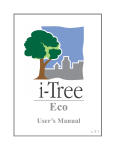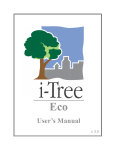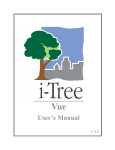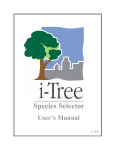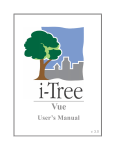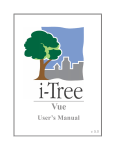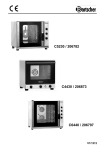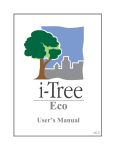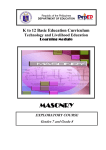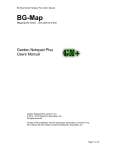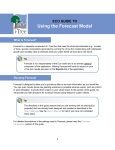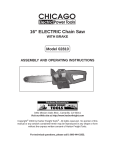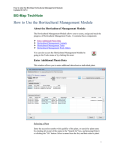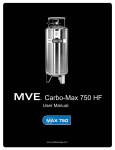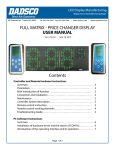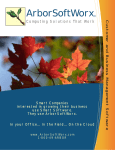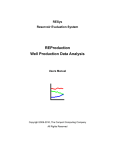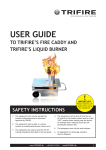Download A Step-by-Step Guide to Taking Urban Forest Inventory Measurements
Transcript
A Step-by-Step Guide to Taking Urban Forest Inventory Measurements This publication provides a step-by-step guide to conducting measurements for use in an urban tree inventory. In general, this guide reflects the measurements included in the U.S. Forest Service’s i-Tree Eco software program; however, the measurements are fairly standard variables used in bottom-up urban forest inventories. Urban Tree Inventories, i-Tree, and Equipment What is a community tree inventory? A community tree inventory performs three primary functions: 1. As a database consisting of information about individual trees. This information includes tree location, diameter, height, canopy width, condition, and hazards. 2. As a maintenance tool, the community tree inventory enables managers to identify trees that need to be pruned, staked, fertilized, cabled, or removed. Urban forest managers use the inventory to periodically review trees that have been identified as hazards. 3. As a management tool, the inventory enables aggregation of individual tree data to provide information about a population of trees—also known as the urban forest. Tree population information includes species distribution and canopy cover. A tree map enables community forest managers to identify and prioritize community canopy goals (e.g., planting and maintenance), while accounting for the condition of the community forest (i.e., dead, critical, poor, fair, good, very good, or excellent). Creating a visual map of how urban forest benefits are distributed across the landscape is known as benefit mapping. A key aspect of benefit mapping is applying a dollar value to trees based on their individual characteristics. Using computer software, economic value can be assigned to ecosystem service benefits of urban trees such as pollution removal (e.g., ozone, sulfur dioxide, nitrogen dioxide), carbon sequestration, and energy savings. What is a bottom-up tree inventory? A bottom-up inventory generates primary data from on-the-ground inventory methods as opposed to aerial or satellite imagery (i.e., top-down inventory). This approach requires a process of measuring individual tree characteristics and quality assurance/ control. Field data collection requires extensive planning, management, and time. Although it can be somewhat costly, the results can provide more information than possible through top-down analyses. For these reasons, it is beneficial to perform a bottom-up inventory at some stage of the community tree inventory. What is the scope of the bottom-up inventory (or how much is enough)? The scope, also known as the sample, is one the most important decisions made in planning a bottom-up urban forest inventory. Determining the scope of the survey depends on available resources and goals. Inventory projects have ranged from parks to small neighborhoods to cities to counties. A statistical representation of the urban forest requires a random sample, whereby plots are placed randomly across the landscape within the boundaries of the study area (e.g., the official city limits). A simple random sample is the most basic form of random sample. A simple random sample, however, may not provide a true picture of forest cover since the urban forest is usually not distributed across the landscape randomly. In a stratified random sample in Tupelo, MS (N=200). The green areas represent trees. There are more points located in tree areas than in the simple random sample. and other public areas. This project scope measures each tree in the designated area. A full inventory is usually not a practical alternative for assessing the urban forest. Because a full inventory is unlikely to be implemented across the entire community, it does not usually provide a true representation of the urban forest. What is i-Tree? Simple random sample in Tupelo, MS (N=200). The green areas represent trees. Several urban forest inventory software packages are available. Some are freeware (licensed to use free of charge), while others can be fairly expensive. Inventory software should have some basic data entry fields such as Global Positioning Systems (GPS) coordinates and tree species. Preferably, additional entry fields would include tree height, diameter, crown width, crown missing, dieback, and land use and ground cover attributes. Canopy measurements are needed to assess canopy attributes. A stratified random sample offers an alternative statistical representation with plots randomly allocated according to land use. A stratified random sample decreases the amount of plots wasted on sites with little or no trees (e.g., large commercial parking lots and agriculture fields). However, because such sites are important characteristics of any populated place, some plots will still be located there. Research has found that 200 tenth-acre plots in a given area provide enough information for statistical inference and benefit mapping while also maintaining an acceptable level of costs associated with data collection (Nowak et al. 2008). Fewer points may be appropriate for a small area, but a greater number of points decreases error in the sample. A statistical sample mitigates the effects of data collection error and landscape variation. The project facilitator will add 5–10 percent more plots as “extra plots” in case some of the original 200 are inaccessible. Once the community determines the scope, the project facilitator will locate the plots on a map using Geographic Information System technology. Plot center geo-coordinates and the map will then be distributed to volunteers. One of the most commonly employed programs is the USDA Forest Service’s i-Tree, available online at www. itreetools.org. i-Tree is a software suite produced with the collaboration of private and public partners. Currently, there are six applications: Eco, Streets, Hydro, Vue, Design, and Canopy. Each application focuses on specific objectives. For example, Eco provides a broad spectrum of data fields that, when combined with air pollution and meteorological data, quantifies community forest structure and environmental effects and applies a monetary value to tree benefits. By contrast, Hydro simulates the effects of changes in tree and impervious cover characteristics on stream flow and water quality. The i-Tree software suite is peer-reviewed, public domain, easy-to-use software that allows for scalable Finally, a full inventory (also called a 100 percent inventory) is often used to measure street trees, parks, 2 analysis. In other words, results can be generalized from individual trees to neighborhood to city levels based on a sample inventory. From this information, users can make management recommendations such as species selection, address invasive species, and perform storm damage assessment. The remainder of this article focuses on the data entry variables found within i-Tree Eco. How is the data recorded? Diameter tape Example data sheets and respective “cheat sheets” for the plot inventory (Appendices 1 and 2) and the full inventory (Appendices 3 and 4) can be found in the appendix to this document. The advantage of paper data input sheets is there is no risk of technological failure, although they may get wet while in the field. However, paper data sheets are somewhat cumbersome to use. Due to the number of variables, the data sheet must be printed on 8.5 by 11 inch paper. In addition, paper requires an additional step—entering the data into an electronic database—after measurements are taken. To address these deficiencies in paper data sheets, the MSU Extension Service will soon make available a smartphone application that includes each variable found in the paper data sheet. The app will be downloadable to iOS and Android platforms from the MSU Extension Service app store. Clinometer Compass GPS unit PowerPoint presentations, literature, and additional information on procedures. In addition to groundcover, stem, and canopy measurements, we include at least a basic (yes/no) hazard observation measure. If desired, a positive response to this measure on the data sheet indicates the need to complete the hazard identification sheet (Appendix 5). Each of the measurements found on these data sheets will be explained in the following sections. Plot Information The first measurements describe the plot where the tree(s) is found (Appendix 1 and Appendix 2, page 1). Plots are one-tenth of an acre, or 37.2 feet in radius. Once plot center is found using a GPS unit, the data collectors measure a radius of 37.2 feet from plot center using a diameter tape. Every tree with at least half the stem falling inside the radius is considered within the plot and should be measured. The following is replicated from the Sample Plot Cheat Sheet (Appendix 1). If a plot is located on private property, access must be granted by the owner (Appendices 6 and 7). What equipment is needed? MSU Extension recommends four pieces of equipment to conduct a basic volunteer inventory: 1. diameter tape 2. compass PLOT ID: Enter plot ID. As mentioned above, plots are randomly created within the border of a given area. The plot ID is assigned by the Geographic Information System (GIS) software. The facilitator describes the location of the plot using roads and other geographic landmarks. A copy of a large-scale photo helps the volunteers get 3. clinometer 4. GPS unit While additional equipment or more expensive equipment could be used, we find this equipment is appropriate for limited budgets and for use with volunteers who borrow the equipment. If available, smartphone apps may be used instead of the handheld compass and GPS. Procedures Note: We suggest urban forest inventory facilitators create an online public folder (e.g., Dropbox, Google Drive) where volunteers can access maps, documents, Recording data onto the data sheet. Always use a pencil. 3 reasonably close to the plot. Then, GPS is used to get within 30 feet of the plot center. GPS UNIT: Enter GPS unit ID. Crew ID and GPS unit ID are used to trace the data back to volunteer collectors as part of quality control. If using the smartphone app, not applicable (NA) can be entered here. PLOT WP: Enter GPS waypoint of plot (not trees) (Appendix 8). Typically, a handheld GPS unit is used (if the MSU Extension urban inventory app is not used), which incorporates error up to around 30 feet. The volunteer attempts to arrive as close as possible to the coordinates indicated by the GPS. At this point, the volunteer marks a “center point” of the plot using a landscaping flag, stick, rock, or some other object. The plot is then measured using a radius of 37.2 feet (37 feet and 13/32 inches), or one-tenth of an acre. Different-sized plots can be used, but Nowak et al. (2008) suggest one-tenth acre is most effective for PLOT ADDRESS: If the plot (or any portion) is located on private property, enter the plot address, including street number, street, and zip code. PLOT PHONE: If the plot (or any portion) is located on private property, enter the telephone number. The telephone number will be available after the property owner has consented to the procedure (Appendices 6 and 7). In some cases, special permission will need to be granted to access public property. In such cases, the same permission documentation should be used with access granted by the supervising authority. OWNER NAME: Record the name of the owner of property (if public, note government entity). NOTES: Record anything noteworthy here. Record lack of access (e.g., property owner refusal or environmental conditions). ACTUAL LAND USE AND PERCENT IN: The letter from the list below is recorded along with percent of each land use that falls within the plot. Proportions are recorded in increments of 1–5 percent, then every 5 percentage points. As with other qualitative estimates in the inventory, land use should be discussed and agreed upon by team members. Up to four land uses can be recorded. Below are the land uses recognized by i-Tree. Making a waypoint using GPS. i-Tree statistics. Trees are considered within the plot if at least half the stem at 4½ feet (known as diameter at breast height or DBH) lies within the radius measure. Residential (R) Multi-family residential (M) Commercial/Industrial (C) Park (P) Cemetery (E) Golf Course (G) Agriculture (A) Vacant (V) Institutional (I) Utility (U) Water/wetland (W) Transportation (T) Other (O) PLOT TREE COVER: Record the estimated percent of tree canopy over the plot. This is another qualitative estimate that should be discussed among team members. This one-tenth-acre plot has three trees. Tree number four is more than halfway out of the plot, while tree number 1 has more than half the stem inside the plot boundary. SHRUB COVER: Record the estimated percent of shrub cover in the plot. The facilitator will inform the volunteers what is classified as shrub cover. DATE: Enter date of work. CREW: Enter crew ID. A unique crew ID is assigned by the facilitator. 4 Maintained grass (MG) Unmaintained grass (UG) Water (W) This plot has approximately 4% T, 1% W, 95% R. This plot has approximately 40% tree cover, 0% shrub cover, 2% T, 1% C, 1% W, 1% B, 95% MG. The number of trees on a plot can range from none to many. GROUND COVER: Record the percent ground cover in plot, which must total 100 percent. The crew notes the percentage of the plot ground area that is covered by the materials below. Estimation may be facilitated by dividing the plot in halves or quarters, then summing the proportions of each section. Ground covers in this plot include tar, maintained grass, and some mulch around the tree. The land use is institutional. The following metrics are for individual trees within the plot (Appendix 1 and Appendix 2, page 2). Data collection for living and dead trees starts with the tree closest to due north and proceeds in a clockwise direction. Building (B) Concrete (C) Tar (T): Blacktop/asphalt Rock (R): Pervious rock surfaces such as gravel, brick, or flagstone walkways or patios (without mortar). This category includes sand in playgrounds or added as topping to existing soil. Large solid rock outcrops should be listed as concrete. PLOT ID: Enter the plot ID from page 1 (Plot Information) so that the individual tree information can be linked to the correct plot. PLOT WP: Enter the GPS waypoint for the plot from page 1. Bare soil (S) TREE ID: Record the tree species (U if unknown, and take a photo and send to the facilitator) using the UFORE abbreviations (www.itreetools.org/eco/resources/ufore_species_list_apr30_2012.pdf). The MSU Duff/mulch (D) Herbs (H): Herbaceous ground cover, other than grass, including agricultural crops 5 Extension Service currently offers a smartphone application called Tree Census with the list of species. A relevant tree must be greater than or equal to 1 inch at 4½ feet. Dripline The following land uses are used in the i-Tree software. Using the tree code app to record the tree ID UFORE abbreviation. Residential (R) Multi-family residential (M) STATUS: The crew should discuss and come to consensus about whether the tree was: Commercial/Industrial (C) P: Planted—the tree was planted intentionally (often characterized by orderly patterns, e.g., rows, and landscaping); Cemetery (E) Park (P) Golf Course (G) Agriculture (A) I: Ingrowth—the tree self-seeded; Vacant (V) U: Unknown—planted vs. ingrowth cannot be determined. Institutional (I) Utility (U) Record dead trees as -1 and skip to the site variable. Water/wetland (W) DR: Record the direction of the tree from the center of plot using azimuth in degrees. DR and DS are used as geographic references in addition to the plot center waypoint. Geographic references are important for future inventory updates. Transportation (T) Other (O) DBH: Record the tree’s DBH (a relevant tree must be greater than or equal to 1 inch at 4½ feet) on the uphill side of the tree to the nearest 0.1 inch/cm. Record up to six stems (≥1 inch) if the pith union is belowground. If more than six stems, lower the measurement height to 1 foot aboveground and record the DBH of the six largest stems. See Appendix 9 for DBH measuring procedures. A smartphone app makes recording direction easy. pith intersection DS: Record the distance of the tree from plot center to the edge of the trunk. LAND USE: The previous land use metric indicated land use within the entire plot; this metric records land use under individual tree canopies in the plot. Record the land use to drip line of the tree crown. The drip line is the very edge of the crown. Most of the time, this will be the same as the land use recorded for the plot. Measuring DBH in multistemmed trees. 6 Height to crown base: Measure the tree height to the base (the lowest live foliage) of the crown. If the base is not reachable using the diameter tape, the clinometer must be used and measured using the same procedure as measuring total height. TREE HEIGHT: i-Tree requires three height measurements (Appendix 10). Total tree height: Measure the height of the tree to the highest visible branch (alive or dead). Height to live top: Measure the height to the highest visible live branch. This height will be the same as total tree height unless the tree is alive but the top of the crown is dead. Using the diameter tape to measure DBH. Follow the correct procedure to hold the tape (Appendix 9). Measuring height to crown base using a diameter tape. CROWN Crown width: Measure the width of each tree’s crown (to the nearest foot). Two volunteers are needed to measure the crown width. Making sure the diameter tape touches the tree stem to approximate the diameter of a circle encompassing the crown, hold each end of the tape to the drip line and record the measurement. This procedure should be repeated in two perpendicular directions: north–south and east–west. Measuring tree height using a clinometer. Follow the correct procedure to hold the clinometer (Appendix 10). Extent of live top Measuring crown width east and west. If the tree does not have any dead branches at the top, the height to live top is the same as total height. In the case of this tree, height to live top is shorter than total height. 7 25% crown dieback This tree has approximately 25% crown dieback. Crown light exposure (CLE): Record the number of sides of the tree receiving sunlight. The maximum is five (four sides and top). As a rule of thumb, include each side that receives at least 50 percent sunlight. Measuring crown width north and south. Percent canopy missing: This metric estimates the percent of branches and foliage that is absent due to pruning, defoliation, uneven crown (i.e., irregular due to damage or some other negative abiotic or biotic impact), or dwarf or sparse leaves. 10% missing crown 25% missing crown Imagine a box covering the crown to measure CLE. A tree can have up to five sides exposed to sunlight. Impervious Surface: Estimate the percent of the area beneath the dripline of the tree that is impervious to water. Often, this will reflect the single tree metric for land use (above). An impervious surface is one that does not allow water to penetrate into the soil. Greater areas of imperious surface result in increased runoff. This tree has approximately 35% of its crown missing. Crown dieback (DB): Record percent branch dieback on each side and top of crown area. Dieback is a condition in which a tree or shrub begins to die from the tip of its leaves or shoots backward, resulting from disease or an unfavorable environment. TREES NEAR BLDGS: Identify trees (≥20 feet tall) that are located within 60 feet of space-conditioned residential or commercial buildings that are three stories or fewer in height (e.g., two stories and an attic). Record the direction (D = azimuth in degrees) from the tree to the closest part of the building and the distance (S = if >60 ft., just note >60 ft.). These metrics are needed for calculating energy savings. SITE: Indicate whether the tree is a street tree (yes = Y) or not a street tree (no = N). A street tree is any tree or part of tree, including the canopy and root systems, that lies on or has grown onto or over public property, or in public right of way owned by a public entity. 8 Additional Reading David J. Nowak, Jeffrey T. Walton, Jack C. Stevens, Daniel E. Crane, and Robert E. Hoehn (2008) Effect of Plot and Sample Size on Timing and Precision of Urban Forest Assessments. Arboriculture & Urban Forestry, 34(6):386–390. David J. Nowak, Daniel E. Crane, Jack C. Stevens, Robert E. Hoehn, Jeffrey T. Walton, Jerry Bond (2008) A Ground-Based Method of Assessing Urban Forest Structure and Ecosystem Services. Arboriculture and Urban Forestry, 34(6):347–358. Jason Gordon. Community Forestry: Another Way of Thinking about Forest Management, IS1958. MSU Extension Service. Measuring distance to the closest building using a diameter tape. Jason Gordon. Conducting a Community Tree Inventory, P2811. MSU Extension Service. HAZARD: Mark yes or no to indicate whether the overall tree, foliage, branches/bole show indications of pest, disease, or if tree/branches could be a hazard. A hazard is any tree/part of tree that may cause harm to people or property (e.g., car). It is important to understand that only a certified arborist should conduct a complete tree risk assessment due to liability concerns. However, because they are observing many trees, volunteers are invaluable for identifying obvious, major problems. If a tree is a hazard, complete the additional hazard identification form (Appendix 5). If a hazard is indicated, arborists will return to the tree to assess it. US Forest Service. (n.d.) i-Tree Streets User’s Manual v5.x.. Retrieved January 19, 2015, from www.itreetools.org/eco UFORE Methods (n.d.) Retrieved January 19, 2015, from http://www.itreetools.org/eco/resources/ UFORE%20Methods.pdf 9 Appendix 1. Image of data sheet (page 1, Plot Data) to be used for sample plots inventory. 10 Appendix 1 (continued). Image of data sheet (page 2, Tree Data) to be used for sample plots inventory. 11 Appendix 2: Cheat sheet to be used for sample plots inventory data sheet PAGE 1 (Plot data) PLOT ID: Enter plot ID PLOT WP: Enter GPS waypoint of plot (not trees) DATE: Enter date of work CREW: Enter crew ID GPS UNIT: Enter GPS Unit ID PLOT ADDRESS: Self explanatory PLOT PHONE: Self explanatory OWNER NAME: Owner of property (if public, note government entity) NOTES: Record anything noteworthy here. Record lack of access (e.g., property owner refusal, poor environmental conditions) ACTUAL LAND USE AND PERCENT IN: Record land use and percent in plot. Residential (R) Golf Course (G) Water/wetland (W) Multi-family residential (M) Agriculture (A) Transportation (T) Commercial/Industrial (C) Vacant (V) Other (O) Park (P) Institutional (I) Cemetery (E) Utility (U) PLOT TREE COVER: Record percent tree cover in plot. SHRUB COVER: Record percent shrub cover in plot. GROUND COVER: Record percent ground cover in plot. Must add to 100%.The crew notes the percentage of the plot ground area that is covered by the following materials: Building (B) Bare soil (S) Concrete (C) Duff/mulch (D) Tar (T): Blacktop/asphalt Herbs (H): Herbaceous ground cover, other than grass, including agricultural crops Rock (R): Pervious rock surfaces such as gravel, brick, or flagstone walkways or patios (without mortar). This category includes sand in playgrounds or added as topping to existing soil. Large solid rock outcrops should be listed as concrete. Maintained grass (MG) Unmaintained grass (UG) Water (W) 12 PAGE 2 (Tree data) Data collection for living and dead trees starts with the tree farthest to the north and proceeds in a clockwise direction. PLOT ID: Enter plot ID from page 1 PLOT WP: Enter GPS waypoint for plot from page 1 TREE ID: abbreviated tree species (U if unknown, and take photo and send to coach) STATUS: P: Planted—the tree was planted intentionally; I: Ingrowth—the tree self-seeded; U: Unknown—planted vs. ingrowth cannot be determined. Record dead trees as -1 and skip to Site. DR: Direction of tree from center of plot (azimuth in degrees) DS: Distance of tree from plot center to edge of trunk LAND USE: Record land use to drip line Residential (R) Golf Course (G) Water/wetland (W) Multi-family residential (M) Agriculture (A) Transportation (T) Commercial/Industrial (C) Vacant (V) Other (O) Park (P) Institutional (I) Cemetery (E) Utility (U) DBH: Record the tree’s DBH (≥ 1 inch at 4.5 feet) on the uphill side of the tree to the nearest 0.1 inch. Record up to 6 stems (≥1 in) if the pith union is below ground. If more than 6 stems, lower measurement height to 1 ft above ground and record DBH of up to the 6 largest stems. TREE HEIGHT: Total tree height: Measure the height to top (alive or dead) of tree. Height to live top: This height will be the same as total tree height unless the tree is alive but the top of the crown is dead. Height to crown base: Measure height to base of live crown. CROWN Crown width: Measure crown width (to nearest foot) in two perpendicular directions: north-south and east-west. Percent canopy missing: Estimate the percent foliage that is absent due to pruning, defoliation, uneven crown, or dwarf or sparse leaves. Crown dieback (DB): Percent branch dieback on side(s) and top of crown area. Crown light exposure (CLE): Number of sides of the tree receiving sunlight from above (maximum of five). Percent impervious surface under the tree: Estimate the percent of the area beneath the dripline of the tree that is impervious. TREES NEAR BLDGS For trees (≥20 ft. tall) that are located within 60 ft. of space-conditioned residential buildings that are three stories or fewer in height (two stories and an attic), record the direction (D = azimuth in degrees) from the tree to the closest part of the building and the distance (S = if >60 ft, just note >60 ft). SITE Indicate street tree YES (Y) or NO (N) if tree is located on edge of street. HAZARD Mark YES (Y) or NO (N) if overall tree, foliage, branches/bole show indications of pest, disease, or if tree/branches could be a hazard. A hazard is any tree/part of tree that may cause harm to people or property (e.g., car). We are looking for obvious, major problems here. If tree is a hazard, complete additional hazard identification form. If a hazard is indicated, arborists will return to the tree to assess it. 13 Appendix 3. Image of data sheet to be used for 100 percent inventory. Appendix 4: Cheat sheet to be used with 100 percent inventory data sheet 100 Percent Inventory Cheat Sheet DATE: Enter date of work CREW: Enter crew ID GPS UNIT: Enter GPS Unit ID LOCATION: Enter location – “Miller Park” LAND USE: Record the predominant (>50%) land use in which the trees are located Residential (R) Golf Course (G) Water/wetland (W) Multi-family residential (M) Agriculture (A) Transportation (T) Commercial/Industrial (C) Vacant (V) Other (O) Park (P) Institutional (I) Cemetery (E) Utility (U) WP: Enter GPS waypoint TREE ID: abbreviated tree species (U if unknown and take photo) STATUS: P: Planted—the tree was planted intentionally I: Ingrowth—the tree self-seeded U: Unknown—planted vs. ingrowth cannot be determined -1: Dead trees GROUND COVER: Must add to 100%. The crew notes the percentage of the plot ground area that is covered by the following materials (up to 4): Herbs (H) Concrete (C) Rock (R): Pervious rock surfaces such as gravel Tar (T): Blacktop/asphalt Bare soil (S) Unmaintained grass (UG) Duff/mulch (D) Water (W) Building (B) Grass (MG) DBH: Record the tree’s DBH (≥ 1 in at 4.5 ft) on the uphill side of the tree to the nearest 0.1 inch/cm. Record up to 6 stems (≥1 in) if the pith union is below ground. If more than 6 stems, lower measurement height to 1 ft above ground and record DBH of up to the 6 largest stems. TREE HEIGHT: Total tree height: Measure the height to top (alive or dead) of tree. Height to live top: This height will be the same as total tree height unless the tree is alive but the top of the crown is dead. Height to crown base: Measure height to base of live crown. CROWN Crown width: Measure crown width (to nearest ft or m) in two perpendicular directions: north-south and eastwest. Percent canopy missing: Estimate the percent foliage that is absent due to pruning, dieback, defoliation, uneven crown, or dwarf or sparse leaves. Do not include normal interior crown voids due to leaf shading. Crown dieback (DB): Percent branch dieback on side(s) and top of crown area. Crown light exposure (CLE): Number of sides of the tree receiving sunlight from above (maximum of five). Percent impervious surface under the tree: Estimate the percent of the area beneath the dripline of the tree that is impervious. continued 15 TREES NEAR BLDGS Trees near buildings: Enter the direction (D) and distance (S) to the three closest buildings (if >60 ft, note >60 ft). SITE Indicate street tree YES (Y) or NO (N) if tree is located on edge of street. HAZARD Mark YES (Y) or NO (N) if overall tree, foliage, branches/bole show indications of pest, disease, or if tree/branches could be a hazard. A hazard is any tree/part of tree that may cause harm to people or property (e.g., car). If tree is a hazard, complete additional hazard identification form. 16 Appendix 5. Tree hazard data sheet for volunteer-based urban forest inventories. (Explanation is provided during tree hazard training.) 17 Appendix 6. Property access request form. Dear Homeowner: Local volunteers representing [sponsor] will be conducting an urban tree inventory throughout 2014 and 2015. This project will utilize the i-Tree Eco - Urban Forest Effects (UFORE) Model developed by the US Forest Service to quantify the composition (tree type, size, health, etc.) and environmental benefits of [city]’s trees. Statewide, urban trees are worth billions of dollars and annually provide millions of dollars’ worth of environmental benefits. In addition, the volunteers will assess the health condition of the trees so that the City can prioritize pruning and removals. Altogether, this information is needed to develop a comprehensive urban forest management plan for [city]. Approximately 200 randomly distributed 1/10 acre sample plots have been identified throughout the City. One of these plots (or a portion thereof) is located on your property. We are requesting permission to access your yard to collect information on trees within the sample plot including tree type, size, crown coverage and density, and overall health. There are no immediate benefits to you; however, if one or more of your trees is determined to be in poor condition, a certified arborist will contact you to offer a professional opinion. Measurements will not harm the trees in any way and only trees within the plot will be measured. The volunteers conducting the activity assume full responsibility for any risks of loss or injury to person or property that may be sustained and waive any and all liability, claims, demands, actions and causes of action, whatsoever arising out of or related to any loss, damage, or injury while conducting the inventory on your property. If you agree, please sign the enclosed form indicating your permission or denial for the urban inventory personnel to enter your property for this specific purpose. Please contact Project Coordinator, Jason Gordon, at (662) 3258851 with any questions or concerns you may have. You can keep this letter for your records. Thank you very much for your consideration. Don’t miss this opportunity to have your trees represent city]! Sincerely, [City] Urban Tree Inventory Team 18 Appendix 7. Property access consent form. Urban Tree Study We need your help in gathering data on your city’s trees. Please help by completing the information below and returning this form to the volunteer. Please contact project coordinator Jason Gordon at (662) 325-8851 with any questions or concerns you may have. DATE NAME ADDRESS ZIP CODE TELEPHONE Check Yes, I authorize the urban tree inventory volunteers to access my property today for the purpose of collecting inventory data from trees on or adjoining my property. No, I do not want my trees included in this important study. 19 Appendix 8: Using GPS for Urban Forest Inventories The following information is about using GPS during urban forest inventories. Specifically, we focus on marking waypoints (i.e., geo-coordinates) to record the locations of sample plots and trees. This information was written using the Garmin eTrex 10 as a model, although most current handheld GPS units are similar. Main menu The Power On button is usually on the side of the device. Sometimes it is labeled light. Press the light button to change screen visibility. Press Back to return to a previous screen. From the main menu screen, toggle to the satellite icon and press Enter (Enter is pressing straight down on the toggle button. The GPS unit must be receiving from at least three satellites. Marking Current Waypoint From the menu screen, select Mark Waypoint. Once in the waypoint screen, the GPS uses a default name for the waypoint. Note the GPS coordinates in the location window. Toggle to Done and Enter to save waypoint. Managing Waypoints Use Waypoint Manager to view waypoints. These points may have been generated by the unit itself or uploaded to the device from an external computer. From the menu screen, toggle to Waypoint Manager. By default, the most recently created waypoint is at the top. Note the time and date created. Marker, name, coordinates, and notes can be modified by toggling to the respective window to highlight, pressing enter to initiate the keyboard, and toggling to letters and numbers on the keyboard. After selecting a letter/number, press enter. Because this is a laborious process, we suggest editing in the office instead of the field whenever possible. A waypoint can be deleted by selecting the waypoint, pressing Menu, selecting Delete, and then selecting Yes. To delete all waypoints, in Waypoint Manager, select Menu, then select Delete all. 20 Setup Compass Heading Make sure compass is on heading, not bearing. To change to heading, from the main menu screen, select Compass, press menu, select Setup Heading. A new window appears. In the Go to Line window, select Course. Press Enter. Navigating to a waypoint From the menu screen, toggle to Where To and Enter. Select Waypoints. Select specific waypoint. Note distance from current location and direction. Select Go. Start with an aerial image (e.g., Google Maps) of the general area. Navigate to within a reasonable walking distance of the known location of the destination. At this point, use the GPS device to walk within 30 feet of the destination. Modern handheld units can usually navigate to within 30 feet because error in the GPS system limits accuracy. More advanced, higher-priced devices, such as those used by civil engineers, have less error. Using the compass to navigate To use the compass, first return to the main menu screen. Select compass, then follow the compass noting the GPS heading, course line (indicates the direction you are currently heading), course pointer (indicates direction you should head), and distance to destination. 21 Appendix 9: Measuring Tree Diameter for Urban Tree Inventories Measuring the diameter (DBH) of a tree is easy when you have a diameter tape. A few points are important to keep in mind. First, a diameter tape (D-tape) is a breakable instrument. If you are not careful, the spring within the housing can break, resulting in the tape’s inability to recoil and becoming a tangled web of metal. Second, the metal strip can be sharp, so be careful when handling the tape. Third, MSU Extension recommends a 100-foot diameter tape with distance in tenths of inches. One side of the tape can measure distance, while the other side of the tape is calibrated to pi in order to measure diameter. Diameter tape: Inches side of measurement. Diameter tape: Diameter side of measurement. Measure diameter at about 4½ feet above the base of the tree. Cross hands as in the photo so that the zero at the end of the tape lines up with the diameter metric. Hold the end of the D-tape with the left hand while holding the casing with the right hand. Stand upslope from the base of the tree. Procedure Standing up-slope from the base of the tree, use your right hand to hold the casing and your left hand to hold the end of the tape. Wrap the tape around the tree, remembering to measure at 4½ feet above where the tree meets the ground and keeping the tape level. Avoid wrapping the tape around vines or deformities. If the tree has a deformity (such as a burl) at breast height, measure the diameter just above the deformity. Line up the end of the tape (zero) with the corresponding metric on the diameter side of the tape. The matching metric is the tree’s DBH. Depending on the measurement’s objective, you may want to record to the nearest tenth or nearest inch. 22 Appendix 10: Measuring Tree Heights for Urban Forest Inventories Note: These instructions are for SUUNTO clinometers with a topographical scale (feet). A clinometer is an instrument that measures slope. The concept of the clinometer is rooted in the trigonometry of a right triangle. The volunteer measures slope (the hypotenuse, or rise over run) twice. First, measure to the top of the tree. If you stop here, you have only measured the tree starting at the height of your eye. So you must then measure to the base of the tree (where the tree meets the ground), creating two right triangles. Add these two measurements together to get height. Step 1: Use the diameter tape and measure 66 feet from the base of the tree. Be sure to walk up-slope and have a clear line-of-sight to the top of the tree (if you are down-slope from the tree, a different calculation must be used). Step 2: Standing 66 feet from the tree, use the clinometer to measure to the topmost green leaf that you can see. The dot on the clinometer should be on the top side, facing the tree. The brass loop should be on the bottom, facing the user. Keep both eyes open when looking into the peephole. This produces an optical effect that transposes the cross hair onto the tree you are measuring. If you tilt the clinometer up and down, you will notice the scales have positive and negative numbers. The scale to the right is the topographical scale in feet. Note the negative scale (–) appears when you tilt the clinometer down) and the positive scale (+) appears when you tilt the clinometer up. You must always be aware of whether the number is positive or negative. Dot is barely visible in this photo. Tilt the clinometer to the top of the tree and measure. Source: SUUNTO 23 Step 3: Remaining 66 feet from the tree, measure the base of the tree. This measurement represents the lower triangle in the graphic above. Add the two measurements, in feet, together. The sum is the total height. For example, you get 30 feet to the top, and negative 5 feet to the bottom. The total height of the tree is 35 feet. This YouTube video might be helpful: https://www.youtube.com/watch?v=5H8s2zNRRv8 Tilt the clinometer to the base of the tree and measure. Add the two metrics to complete the height measurement. The information given here is for educational purposes only. References to commercial products, trade names, or suppliers are made with the understanding that no endorsement is implied and that no discrimination against other products or suppliers is intended. Copyright 2015 by Mississippi State University. All rights reserved. This publication may be copied and distributed without alteration for nonprofit educational purposes provided that credit is given to the Mississippi State University Extension Service. By Jason Gordon, Assistant Extension Professor, Forestry, and Brian Templeton, Extension Associate III, Landscape Architecture. We are an equal opportunity employer, and all qualified applicants will receive consideration for employment without regard to race, color, religion, sex, national origin, disability status, protected veteran status, or any other characteristic protected by law. Publication 2882 Extension Service of Mississippi State University, cooperating with U.S. Department of Agriculture. Published in furtherance of Acts of Congress, May 8 and June 30, 1914. GARY B. JACKSON, Director (POD-04-15)

























